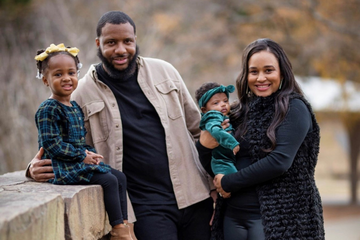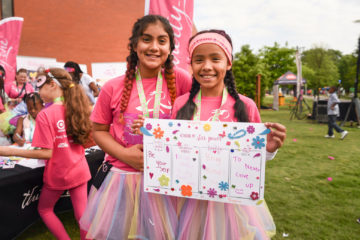How a Team Agreement Can Squash Sibling Squabbles Before They Begin
Growing up is a lot of work. And being a grown-up tasked with helping kids grow up often means that life is full of joy, laughter, and big questions about how to ensure kids develop a sense of compassion and life skills that stick – even when sibling squabbles arise! When you’re the adult in the room and in a home with more than one kid, it might be easy to spot all the different ways that siblings can enrich one another’s lives, like celebrating accomplishments or providing encouragement. Together, they can practice all the big life skills like standing up for themselves and others, showing empathy, embracing differences, etc. They’ll need this attitude and these skills now and in the future. And on other days, you may find your kids butting heads over menial things from sun up to sun down.
Just like no two GOTR participants are alike, no two siblings’ relationships are the same, and often, even the closest siblings find themselves needing the occasional support in the “getting-along” department. Whether your kids tend to get frustrated about who should sit where or who bothered who first, there’s one GOTR go-to tool that they can employ to help navigate conflict, keep the peace, show kindness, and become better listeners even before squabbles begin: the creation of a team agreement!
As coaches discuss in the beginning of every Girls on the Run season, a team agreement is a set of statements created by team members (or, in this case, siblings) that explain how each team member treats one another and wants to be treated. While it’s true that your at-home team probably looks a lot different than a typical GOTR team, supporting your kids in making a team agreement is a simple way to help them learn to navigate the normal disagreements of life without devolving into the sort of squabbles that result in hurt feelings or unresolved frustrations.
Team agreements are also a little different than a set of adult-authored family rules because they are co-created as a team, with each member sharing their ideas and then working together to finalize the list. Creating an agreement as a team is powerful because it gives every member’s voice equal value. And when everyone feels like their opinions are included, they tend to be much more invested in following the agreement.
Here’s how to co-create a team agreement that includes the ideas of every family member and makes everyone feel heard, seen, and supported:
Define ‘Team Agreement’ and explain the process
To get started, schedule a family meeting when everyone is feeling good, relaxed, and open to a new activity. During this time, explain the process of creating a positive, supportive set of guidelines for your family. Open the meeting by sharing the definition of a team agreement with your kids. Once they understand the concept, let them know that each family member will have the chance to share before coming together to create the final list of agreements. Everyone’s words matter, and there are no bad ideas!
As you explain, you can share some examples of agreements that you’ve thought of to help solidify the idea of a team agreement in their minds. However, do your best to avoid giving too many ideas; remember, letting your kids be drivers of the process will result in a team agreement they’re more excited to be a part of.
Brainstorm without judgment
Storm may be in the name, but there are no gray clouds in brainstorming sessions! The goal of the session is not to achieve perfection but to hear what’s on your kids’ minds and let them know you understand what’s important to them. Let your kids know that even if they (or you) disagree with an idea that someone else shares, this is a time for getting everyone’s thoughts on paper and there will be time later to discuss each idea in more depth. When your family is ready to start brainstorming, offer them plenty of time to pause, think, and reflect on their ideas. Depending on their ages and preferred ways of thinking or working, having some notebook paper and something to write with for each kid may be helpful. ,
As you listen to the ideas that come up when it’s time to share, make a note of everything they suggest. Do your best not to rephrase or edit what your kids say as you take notes. If you’re not sure you understand what they mean, take the time to ask so that the notes you end up with are an accurate reflection of their ideas. Being a great listener shows your kids that they are on equal footing in crafting a team agreement.
Vote on a team agreement that works for everyone
After checking to see if everyone shared their ideas, let your kids know that you’re going to work together to narrow down your list into no more than five or six agreements. Remind your kids that they should state agreements in the positive; for example, they can phrase, “no yelling at each other” as “speak at an indoor volume.”
To narrow down your list, work with your kids to group their ideas into broader categories. Suggestions like “no name-calling,” “don’t make rude comments,” and “don’t yell” could all fit into the broader category of “speak kindly to one another.” While you want to put ideas into broader categories to keep your list of agreements manageable, be sure you’re defining what each agreement looks like as you go. For example, if you come up with an agreement like “speak kindly to one another,” be sure you ask your kids questions that keep the specifics clear, like “what does it sound like to speak kindly?”
At the end of this exercise, you should have five to six team agreements that are simple, broad enough that your family can apply across multiple situations. Ensure all agreements are written clearly enough that each family member knows what each one looks like in practice.
Create a visual representation of the agreements you made
Add a little sparkle, shine, and color to your agreement! If you have a crafty kiddo, it’s likely that they will enjoy putting their creative mind to work creating a visual representation of each family member’s agreement. There are lots of “right” ways to complete this project, including writing, typing, and printing, but don’t let those steps prevent your kids from making it special! Let your kids get to work by doing a step of their choosing and playing a vital part in the process. Having each family member sign the team agreement with a signature, handprint, a fun stamp, or another representation of their agreement can close out the project in a memorable, ceremonial manner.
Once your team agreement is complete, discuss where to display it and proudly hang it for all to see! Seeing the team agreement each day serves as an excellent reminder of what the sibling set in your life cares most about and can be a helpful, even inspiring, reference on days when they need it most.
Creating a family team agreement might feel like a lot of work, but having an agreed-upon, basic set of guidelines can work wonders in nurturing the long-term relationship between your kids and reducing sibling squabbles. So the next time there is an argument at the dinner table or an outburst of hurtful comments, you will have a reliable, agreed-upon tool to use to help overcome these challenges, Whether your kids are GOTR girls or not, the team they live and learn with at home is important. Help make that team strong by co-creating a team agreement that will see them through good days, bad days, and all the days in between.
To learn more about what we do and how to register your girl for the upcoming season, click here!



